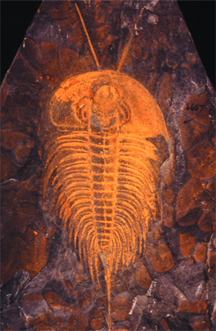 Trilobite diversification
during the Cambrian is thought to exemplify the explosion of animals and plants
530 to 525 million years ago. New research suggests, however, that the trilobites
diversified much earlier, thus calling into question the theory and possible
dates of a biological big bang — and changing the way the world may have
looked at the time.
Trilobite diversification
during the Cambrian is thought to exemplify the explosion of animals and plants
530 to 525 million years ago. New research suggests, however, that the trilobites
diversified much earlier, thus calling into question the theory and possible
dates of a biological big bang — and changing the way the world may have
looked at the time. New research suggests that the biological diversification called the Cambrian explosion may have occurred more slowly than previously thought. Trilobites seem to have diversified before the onset of the Cambrian, with the breakup of a supercontinent called Pannotia. Image courtesy of Joe Meert and Bruce Lieberman.
The so-called Cambrian explosion may have occurred 50 to 60 million years earlier than previously thought, and was likely more of a “slow burn” than an explosion, says Joe Meert, a geologist at the University of Florida. In the May issue of the Journal of the Geological Society of London, Meert and Bruce Lieberman report that the trilobites originated on one margin of a supercontinent and diversified most likely as a result of tectonic movement — the breakup of a supercontinent called Pannotia, which occurred much earlier than previously believed. “I hope our findings will stir things up — get more people interested in testing ideas about the nature of the Cambrian explosion,” says Lieberman, a paleontologist at the University of Kansas.
“This paper implies that trilobites had a long cryptic record probably as small forms without a biomineralized skeleton,” well before the early Cambrian and before the period from which hardened fossils have been found, says Derek Briggs, a geologist at Yale University. That evidence, he says, is consistent with some estimates for the origin of different animal groups. Even without direct fossil evidence, those studies have indicated that organisms may have begun to diversify in the Precambrian. However, the latest study is the first to argue that the breakup of Pannotia may have played a fundamental role in precipitating the Cambrian explosion, Lieberman says.
Scientists have developed at least three leading models of how and when Pannotia broke up, forming four new continents. Meert and Lieberman’s research indicates that the continents most likely did not move exceedingly quickly, as one of the models suggests. Instead, the continents most likely moved at a slightly faster rate (4 to 6 inches per year) than they do today (2 to 3 inches per year).
“Our goal was to understand the paleogeography of the latest Neoproterozoic and early Cambrian time using the evolutionary history of trilobites,” says Meert, who specializes in paleomagnetism. However, paleomagnetic data can be interpreted in different ways, he says, and trilobites “gave us an independent test for the paleogeographies” of this time period.
Although the researchers say they have eliminated one of the three models of Earth’s continents and continental move in the late Precambrian and early Cambrian, they hope their research will lead to further testing of the other two models. “The solution to resolving the debate is, as ever,” Briggs says, “more data.”
Megan Sever
Back to top

